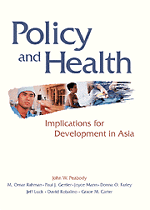Book contents
- Frontmatter
- Foreword
- Preface
- Contents
- Tables
- Figures
- Boxes
- Chapter One OVERVIEW: THE ROLE AND RESPONSIBILITY OF GOVERNMENTS IN THE HEALTH SECTOR
- Chapter Two EVIDENCE-BASED POLICY: USING DATA TO INFORM POLICY AND IMPROVE HEALTH OUTCOMES
- Chapter Three PRIORITIZING MEDICAL INTERVENTIONS: DEFINING BURDEN OF DISEASE AND COST-EFFECTIVE INTERVENTIONS IN THE PURSUIT OF UNIVERSAL PRIMARY CARE
- Chapter Four FINANCING AND ALLOCATING PUBLIC EXPENDITURES: LEVERAGING PUBLIC RESOURCES TO MEET OBJECTIVES AND INCREASE PRIVATE PARTICIPATION
- Chapter Five TOWARD BETTER EQUITY AND ACCESS: PERSISTENT POVERTY, INADEQUATE INTERVENTIONS, AND THE NEED FOR BETTER DATA AND SOLUTIONS
- Chapter Six GOVERNMENT AND THE IMPROVEMENT OF HEALTH BEHAVIORS
- Chapter Seven IMPLEMENTING POLICY OBJECTIVES: THE ROLE AND RESPONSIBILITIES OF THE MINISTRY OF HEALTH
- Acronyms
- Data Notes and Glossary—Chapter Two
- References
- Authors
- Index
- Plate section
Chapter Six - GOVERNMENT AND THE IMPROVEMENT OF HEALTH BEHAVIORS
Published online by Cambridge University Press: 18 December 2009
- Frontmatter
- Foreword
- Preface
- Contents
- Tables
- Figures
- Boxes
- Chapter One OVERVIEW: THE ROLE AND RESPONSIBILITY OF GOVERNMENTS IN THE HEALTH SECTOR
- Chapter Two EVIDENCE-BASED POLICY: USING DATA TO INFORM POLICY AND IMPROVE HEALTH OUTCOMES
- Chapter Three PRIORITIZING MEDICAL INTERVENTIONS: DEFINING BURDEN OF DISEASE AND COST-EFFECTIVE INTERVENTIONS IN THE PURSUIT OF UNIVERSAL PRIMARY CARE
- Chapter Four FINANCING AND ALLOCATING PUBLIC EXPENDITURES: LEVERAGING PUBLIC RESOURCES TO MEET OBJECTIVES AND INCREASE PRIVATE PARTICIPATION
- Chapter Five TOWARD BETTER EQUITY AND ACCESS: PERSISTENT POVERTY, INADEQUATE INTERVENTIONS, AND THE NEED FOR BETTER DATA AND SOLUTIONS
- Chapter Six GOVERNMENT AND THE IMPROVEMENT OF HEALTH BEHAVIORS
- Chapter Seven IMPLEMENTING POLICY OBJECTIVES: THE ROLE AND RESPONSIBILITIES OF THE MINISTRY OF HEALTH
- Acronyms
- Data Notes and Glossary—Chapter Two
- References
- Authors
- Index
- Plate section
Summary
OVERVIEW
The ultimate objective of health care services is to improve health status. In Chapter 3, we saw that choosing the right set of clinical interventions is critical to achieving better health within constrained resources. Chapters 4 and 5 discussed ensuring that all people can afford, and have access to, those interventions. In addition, ensuring that the appropriate medical infrastructure and institutions are in place is also key to achieving better health, as we will see in the next chapter.
However, none of these factors is enough to guarantee improvements in health status. Any intervention—whether clinical or enabling—will not improve the health of individuals if the individuals do not choose to take advantage of it, or if providers do not offer the intervention to their patients. For example, a government can decide to fight a measles epidemic by providing immunizations for children, by allocating public subsidies away from curative services and toward the primary preventive care services, and by geographically targeting communities most in need of measles immunization. None of these interventions, however, will improve measles immunizations for children if the parents do not choose to bring their children into the clinics that provide the service and if community health workers are not skilled.
Figure 6.1 expands the relationship presented in Figure 2.1 to show how health policy affects health status and is mediated by changing behaviors of the stakeholders.
- Type
- Chapter
- Information
- Policy and HealthImplications for Development in Asia, pp. 232 - 275Publisher: Cambridge University PressPrint publication year: 1999



